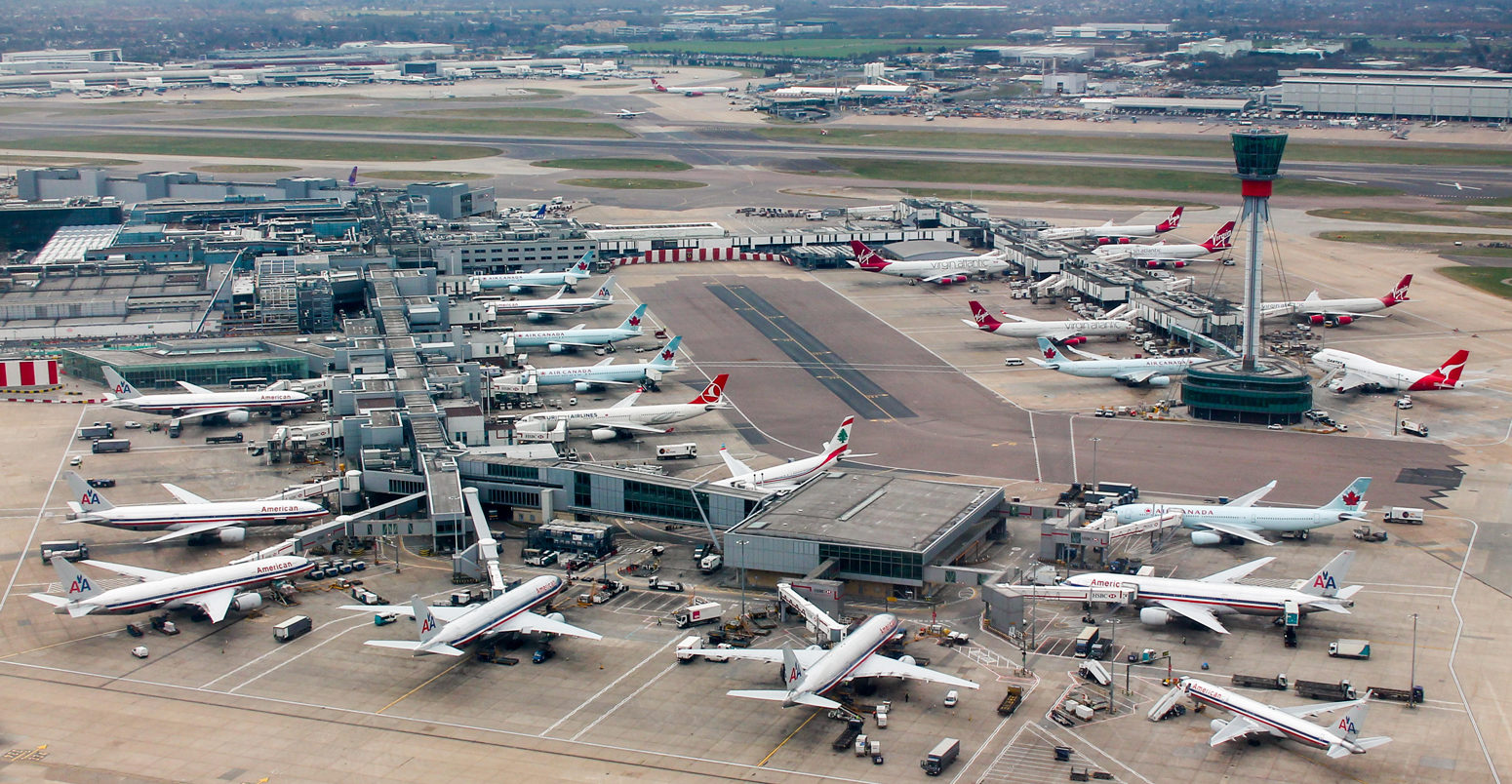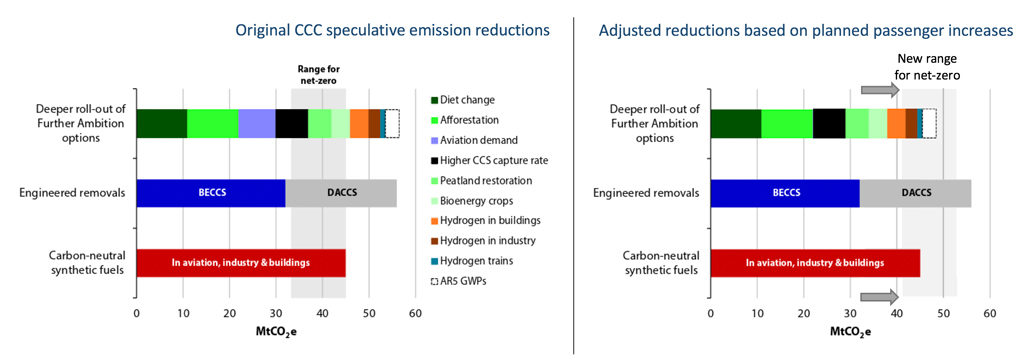
Guest post: Planned growth of UK airports not consistent with net-zero climate goal
Multiple Authors
06.24.19Multiple Authors
24.06.2019 | 8:00amDr Declan Finney is a post-doctoral researcher at the University of Leeds’ Institute for Climate and Atmospheric Science (ICAS); and Dr Giulio Mattioli is a research associate at the Department of Transport Planning at TU-Dortmund in Germany and guest research fellow at the University of Leeds’ Sustainability Research Institute.
For years, plans to expand London’s Heathrow airport have been hotly debated by many sides. One argument against expansion relates to its apparent incompatibility with the UK’s targets to reduce greenhouse gas emissions, which have recently been strengthened to net-zero emissions by 2050.
As well as Heathrow, other airports also have expansion plans. We have investigated the plans from the largest UK airports and found them to be on course for much higher growth than is compatible with the pathway for carbon reductions set out by the Committee on Climate Change (CCC).
Aviation growth and climate change
Evidence to date indicates that unrestricted growth in the aviation sector is unlikely to be offset by technological improvements to efficiency. Up to now, the rapid increase in air-travel demand has always outstripped efficiency and technological improvements in the aviation sector. This is the main reason why the EU’s greenhouse gas emissions from international aviation have more than doubled since 1990 – much faster than for other transport segments.
The recent net-zero report by the CCC sets out comprehensive plans for the UK to reduce its greenhouse gas emissions to net-zero by 2050. The report comments that:
“…given a population that is anticipated to grow and rising incomes, some growth in [aviation] demand is expected. However, this cannot be unfettered. We have maintained our previous assumption that demand grows by 60% relative to 2005 levels (25% relative to today) by 2050”
As implied, this limitation on growth is not a new target: it was already included in the plans to achieve the previous 80% emission reduction target. The CCC will be writing to the government later in 2019 regarding its approach to aviation. The need to revisit government policy on aviation in light of the CCC report has recently been acknowledged by a senior civil servant in the Department of Transport.
Plans for unrestricted growth in UK airports
The private companies that run the UK’s airports each form their own plans for airport growth. We have used various media reports and airport strategy documents to identify the targets for passenger numbers over the coming decades for the largest UK airports (which accounted for 98% of passengers in 2017).
The table below shows the 2017 passenger numbers at each airport and each airport company’s plans to increase capacity. For some of these plans, capacity is already available. For others, development of airport infrastructure is underway, or national or local government approval has been given for some proposals. The remainder have set out plans and intentions of how to develop new capacity in the future.
| Airport | Passengers (2017) | Planned capacity | Increase on 2017 | % increase on 2017 | By year... | Status |
|---|---|---|---|---|---|---|
| Heathrow | 77,987,524 | 130,000,000 | 52,012,476 | 67 | 2050 | approved |
| Gatwick | 45,553,837 | 53,000,000 | 7,446,163 | 16 | 2023 | underway |
| Manchester | 27,773,303 | 55,000,000 | 27,226,697 | 98 | 2050 | available capacity |
| Stansted | 25,902,618 | 43,000,000 | 17,097,382 | 66 | 2030 | approved |
| Luton | 15,989,225 | 18,000,000 | 2,010,775 | 13 | 2020 | available capacity |
| Edinburgh | 13,409,295 | 16,500,000 | 3,090,705 | 23 | 2021 | underway |
| Birmingham | 12,982,180 | 18,000,000 | 5,017,820 | 39 | 2033 | plan |
| Glasgow | 9,894,845 | 16,400,000 | 6,505,155 | 66 | 2040 | plan |
| Bristol | 8,233,387 | 12,000,000 | 3,766,613 | 46 | 2025 | plan |
| Belfast International | 5,836,735 | 10,000,000 | 4,163,265 | 71 | 2030 | plan |
| Newcastle | 5,297,952 | 9,400,000 | 4,102,048 | 77 | 2035 | plan |
| Liverpool (John Lennon) | 4,896,603 | 7,800,000 | 2,903,397 | 59 | 2030 | plan |
| East Midlands International | 4,877,545 | 10,000,000 | 5,122,455 | 105 | 2040 | plan |
| London City | 4,530,439 | 6,500,000 | 1,969,561 | 43 | 2025 | underway |
| Leeds Bradford | 4,074,500 | 7,000,000 | 2,925,500 | 72 | 2030 | approved |
| Aberdeen | 3,090,272 | 4,000,000 | 909,728 | 29 | 2020 | underway |
| Belfast City (George Best) | 2,559,846 | 3,100,000 | 540,154 | 21 | 2030 | plan |
| Southampton | 2,069,605 | 5,000,000 | 2,930,395 | 142 | 2037 | plan |
| Cardiff Wales | 1,464,180 | 3,200,000 | 1,735,820 | 119 | 2040 | plan |
| Doncaster Sheffield | 1,335,590 | 11,800,000 | 10,464,410 | 784 | 2050 | plan |
| Southend | 1,091,738 | 5,000,000 | 3,908,262 | 358 | 2023 | underway |
| Total | 278,851,219 | 444,700,000 | 165,848,781 | 59 |
We find that airports are aiming for an increase of 166 million passengers (59%) on today’s 279 million. This is more than double the suggested increase given in the CCC report.
This figure is an underestimate since we have not considered any additional expansion plans of airports with development already underway or approved. Furthermore, many of the plans above are targets for before 2050 and, therefore, other expansion plans may come about as new strategies are written.
Airports such as Manchester and Luton already have available capacity for around 29 million more passengers, and those airports have stated intentions to drive demand for that capacity. In other cases, such as Gatwick, Edinburgh, London City and Aberdeen, there are already projects underway to increase capacity by around 13 million. This comes to around 42 million additional passengers, which equates to a 15% increase on current demand, namely, more than half of the allowance proposed by the CCC. Much of the investment in these airport expansions is presumably already locked in.
In addition to these, the third runway at Heathrow has been approved by the UK government. This alone accounts for an increase of 52 million (19%) passenger capacity, which, in combination with development already underway, would push future capacity beyond the increase proposed by the CCC.
And that’s not to mention approved expansions at Stansted and Leeds-Bradford airports, which, combined, would add capacity of 20 million passengers. Even if no other airports were to expand, approval of these projects will need to be urgently reconsidered if the government is to follow the plan set out by the CCC report.
Large emission reductions would be needed elsewhere
The CCC report estimates greenhouse gas emissions of 31MtCO2e from aviation in 2050 following a 25% increase in demand on current levels. If there is not a shift towards longer or shorter flights, this will equate to around 350 million passengers travelling in 2050. That’s a bit under 0.1 tCO2e per passenger.
If instead we use the passenger numbers that UK airports are aiming for (445 million), then we estimate emissions could instead be 39MtCO2e from aviation.
The additional 8MtCO2e would add extra pressure on the “speculative” emission reduction/removal options presented in the CCC report:
“Speculative options currently have very low levels of technology readiness, very high costs, and/or significant barriers to public acceptability. It is very unlikely they would all become available by 2050 but some contribution from speculative options is likely and will be required in order to reach net-zero GHG emissions domestically.”
In the figure below, we show the CCC’s speculative emissions reductions scenario for net-zero emissions by 2050 (left) and then adjust it (right) to reflect our new findings. This highlights how the CCC’s range for net-zero reductions must potentially increase by an extra 8MtCO2e.

The left-hand chart is taken from the CCC net-zero report. Shaded area reflects range for additional speculative emissions reductions required to get to net-zero emissions in 2050 (i.e. 33-45MtCO 2 e). CCS is carbon-capture and storage, BECCS is bioenergy with CCS, DACCS is direct air capture of CO2 with CCS. On the right, the CCC figure has been adjusted to reflect the findings of this article. First, arrows show the potential 8MtCO2e extra reduction required if airports expand as planned, thereby increasing the range to 41-53MtCO2e to reach the net-zero target. Second, the “aviation demand” speculative option has been removed as this required roughly no growth in demand above current levels.
One option – the goal of maintaining aviation demand at current levels – appears highly unlikely given the data presented here. Instead, it is likely to increase beyond the CCC limits. Therefore, additional emission reduction/removal is needed instead.
Other options include a higher afforestation ambition or increased engineered removals with carbon-capture and storage technology. However, England is already failing to meet its own tree planting targets and the UK has sent mixed messages regarding funding for carbon-capture and storage.
The CCC includes an option to develop and implement synthetic, carbon-neutral fuel. However, it comments:
“These may be technically possible, but will be thermodynamically and economically challenging, and therefore currently appear likely to be significantly more expensive than other speculative options.”
Is increased aviation demand and expansion ‘inevitable’?
It would be wrong to think of the airports’ expansion plans as a simple response to “inevitable” increases in demand. Transport experts have long shown that supply of transport infrastructures induces demand, creating a sort of vicious circle. This is what happened, for example, with the road-building and road-widening programmes in the 20th century.
There, too, the initial intention was to solve congestion problems and to cope with predicted increases in car travel. We know now that those programmes actually contributed to encourage further car use and that quickly filled up the roads again.
Something similar is happening in the aviation sector right now. Expanded airports are likely to mean more and cheaper flight routes, which, in turn, will encourage more flying.
To curb emissions in the aviation sector, the government could consider measures to “manage” travel demand – ensuring that the number of flights does not increase too much over the next decades.
There are plenty of ideas about how this could be achieved – including the “frequent flyer levy” proposed by the “A free ride” initiative. This would put a charge on frequent flyers, while leaving one flight per year priced at current levels. The majority of people would not be impacted by such a measure. For example, a survey in 2014 found that 74% of adults in the UK had not flown, or had only flown once, during the previous year.
Destination for UK’s aviation growth?
Protest groups, such as Youth Strike 4 Climate and Extinction Rebellion, have identified the inconsistency of airport growth with commitments to limit climate change, which is confirmed by our findings here.
It is clear that the government has not provided necessary guidance for companies planning for airport expansion to ensure that the UK aviation industry as a whole is playing its part in reducing emissions. Furthermore, it is clear that the industry itself has not voluntarily coordinated expansion sufficiently to meet national targets for aviation emission reduction.
Looking forward, there are indications from the Department of Transport that existing approvals for airport expansion will now be revisited in light of the CCC report and subsequent announcement by the government of the new net-zero emission target for 2050.
-
Guest post: Planned growth of UK airports not consistent with net-zero climate goal

